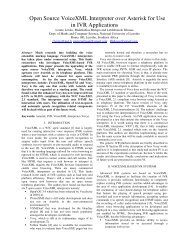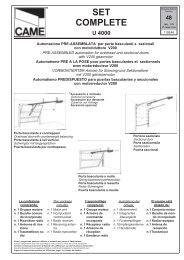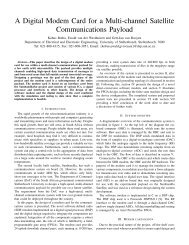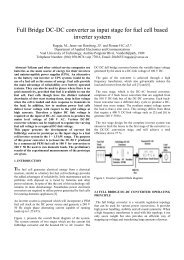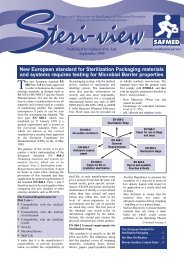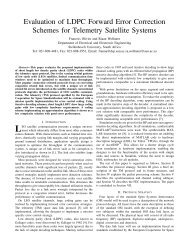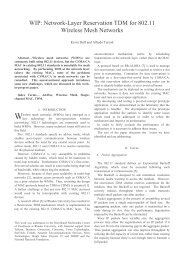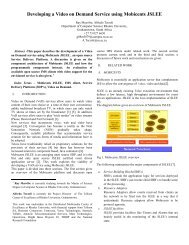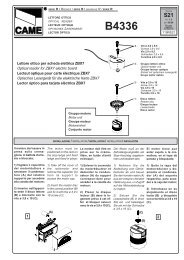physiognomy physiognomy – every face tells a story - Intekom
physiognomy physiognomy – every face tells a story - Intekom
physiognomy physiognomy – every face tells a story - Intekom
Create successful ePaper yourself
Turn your PDF publications into a flip-book with our unique Google optimized e-Paper software.
PHYSIOGNOMY PHYSIOGNOMY – EVERY EVERY EVERY FACE FACE TELLS TELLS A A STORY<br />
STORY<br />
Facial Facial reading, reading, <strong>physiognomy</strong> <strong>physiognomy</strong> or or personology personology can can be be defined defined as as the the relationship relationship between between one’s one’s one’s physical physical features features and and and one’s<br />
one’s<br />
instinctive instinctive behaviour, behaviour, behaviour, personality, personality, character, character, ability ability and and potential, potential, based based upon upon our our our genetic genetic blu blueprint blu eprint and and physical physical physical neurological<br />
neurological<br />
cell cell cell proportion proportion. proportion Dr Edward Vincent Jones, a Californian Superior Court Judge, rediscovered and developed this technique during<br />
the 1930’s. Having <strong>face</strong>d many hundreds of people during his many years on the bench he noticed a pattern between certain<br />
facial characteristics and behaviour. He started to compile a list of these physical traits and matched them to expected<br />
behavioural traits, eventually only accepting those that exhibited a 92%+ accuracy score. After many years his skill at judging<br />
character became legendary and he eventually began to give classes in what he termed, Personology. Dr Jones believed that<br />
the genetic influence from the parents at the time of conception was probably not equal and that the offspring would more<br />
than likely exhibit more traits from the dominant or more constitutionally sound parent.<br />
However the hi<strong>story</strong> of <strong>physiognomy</strong> actually goes back a lot further than this. Think Hippocrates, Pythagorus, Aristotle and<br />
Plato. Hippocrates used the principles of <strong>physiognomy</strong> to assist in his diagnosis by considering the possible emotional cause of<br />
his patients condition. Early Chinese and Indian hi<strong>story</strong> makes reference to <strong>face</strong>-reading, as do the writings of the Romans, the<br />
Arabs and the Jews (the Zohar in particular). Later again during the European Renaissance period one can refer to Leonardo da<br />
Vinci, Michelangelo, Sir Francis Bacon, Shakespeare, Raleigh and Descartes to name a few.<br />
Dr Franz Joseph Gall, universally considered the ‘father of brain research’, was the first in recent times (1800) to publish<br />
scientific papers on the significance of cell proportion to instinctive human behavioural traits. However, a hundred years later<br />
Freud’s theories completely changed the way people viewed each other and at that point, the understanding of human nature<br />
pretty much became the sole realm of the professional analyst. Personology disappeared off the scene during the Second<br />
World War. Thereafter ‘behaviorism’ came to the fore, maintaining that people were merely products of their environment and<br />
conditioning.<br />
However, during the 1950’s, followers of Jones’ original teachings, Robert and Elizabeth Whiteside (Personology Foundation of<br />
Los Angeles), decided to subject his data to scientific scrutiny and implemented statistical procedures over a period of ten<br />
years to validate Jones’ original findings. The accuracy astounded them. Jones’ information regarding the traits were accurate<br />
99% of the time.<br />
Of course the ‘whole’ person is never revealed in the <strong>face</strong> alone, and one has to think of this technique as a doorway into<br />
establishing rapport with someone, based on the type of traits one is likely to expect in that person, thereby leading to greater<br />
understanding and acceptance of that person as a unique individual. Always, though, in relation to one’s own, intrinsic,<br />
reactive functioning.<br />
Kinesiologists use their knowledge of Personology to help identify and defuse blocked potential in their clients, thereby<br />
assisting the client in accepting and understanding their own (and perhaps others) essential, genetic nature. This brings them<br />
to an awareness that they have a choice in creating or maintaining the behavioural trait which either moves them towards, or<br />
away from, their goals. Genetically we may be predisposed to certain responses to/in life, but our belief system can influence,<br />
change or suppress our true selves. However, over and above <strong>every</strong>thing else, once we become conscious as to who we really<br />
are, we have the freedom to CHOOSE to act or react, differently.<br />
Our structure and our functioning is very much a part of our non-conscious awareness. We judge people all the time based on<br />
how they look. You meet a stranger and form an immediate opinion, based on your feelings prompted by that person’s facial<br />
features. But understand WHAT you are seeing and your accuracy will improve a great deal, and, furthermore, it will be based<br />
on knowledge rather than a conditioned belief system (an example here might be the ‘dumb blond’ stereotype!)<br />
A great example of Personology in action is Hollywood ‘type-casting’! If you look the part, you’ll probably get it. How many actors<br />
seemingly repeatedly play either the ‘good guy’ or the ‘bad guy’ in film after film after film?!<br />
Personology has identified six main trait areas being Thinking Thinking, Thinking<br />
, , Action, Action, Feeling Feeling or or Emotion, Emotion, Automatic Automatic Automatic Expression, Expression, Physical Physical and<br />
Current Current Outlook Outlook Trait Trait. Trait These are further subdivided into approximately 50 different behavioural traits, each one with unique<br />
physical identifiers. A reasonable working knowledge of these traits can be extremely useful to <strong>every</strong>one - from human<br />
resource managers, therapists, and managers to teachers, parents and neighbours because it offers a good understanding of<br />
how that person ‘does life’. Let’s look at a few examples….<br />
Firstly, look at your hands hands. hands<br />
The degree of hand co-ordination can be distinguished quite easily by looking at the length of the<br />
forefinger, middle and ring fingers. The more even their length, the better the hand and finger co-ordination is likely to be.<br />
People whose fingers have varied lengths have to concentrate harder on what they are doing so they naturally gravitate<br />
towards pursuits that are more mental than practical.<br />
An idea as to a person’s basic temperament can be gauged by simply observing skin and hair texture (based upon the<br />
thickness of a single hair strand). Individuals with thicker hair strands could be expected to be of a coarser temperament.<br />
Along with this would go a rougher skin, a more deeply lined <strong>face</strong>, and they would exhibit a more forceful, loud or rugged<br />
nature. They may also often be referred to as being quite “thick skinned”! They love to work and be outdoors in a physical<br />
environment. Conversely, people with fine hair and skin are more sensitive to their emotional and physical environment, would<br />
be comparatively more reserved, discriminating and generally drawn to the more refined and finer pleasures of life! They are<br />
also far more intuitive.
No No two two two sides sides sides of of the the <strong>face</strong> <strong>face</strong> are are exactly exactly exactly alike alike. alike alike Take a frontal facial photograph of yourself and draw a vertical line down through the<br />
forehead to the chin. Compare both sides. The greater the difference between the two sides, the greater the possibility for<br />
inner disharmony. Princess Diana is a classic example (see below). The more equal and balanced the different halves, the<br />
more consistent is your approach to life. Consistency in a person can also be seen by comparing the eye placement between<br />
left and right. The more uneven the eyes, the less consistent or conventional that person would be to someone whose eyes are<br />
quite level.<br />
Eyes Eyes are a huge window into the soul. Their shape, placement, whether they recede or protrude and many other factors give us<br />
clues to personality traits. People whose eyes are closer together (think Prince Charles) tend to be less tolerant of mistakes<br />
(whether their own or others) than others whose eyes are wider apart (think Oprah). When considering this aspect one also<br />
needs to consider the space between the eyes being less than the eye’s width. Close set eyes also indicate a tendency towards<br />
perfectionism. Make sure your accountant has eyes that are close together because these people are also quite focused<br />
(specific to the tasks at hand) and are also very time conscious! Wider-set eyes indicate a comparatively more good natured<br />
and easy-going persona. Small wonder Chuck and Di never saw ‘eye to eye’! A fold of skin over the eye (known as an epicanthic<br />
fold – predominant in persons of Asian extraction) which could cover the upper eyelid completely identifies the analytical trait<br />
in people. The larger and more pronounced this fold, the more analytical the person tends to be, wanting to know "why" about<br />
<strong>every</strong>thing. Next time your child keeps asking ‘but why mom?!’ have a look for this trait – the classic answer ‘just because’ will<br />
never satisfy them! Individuals with no epicanthic fold at all tend to be more right-brained in that they rely more on their<br />
instinctive selves.<br />
People with large irises will express their emotions and feelings very easily. For instance a baby has very large irises in relation<br />
to the sclera (white portion) – and they are very quick to let you know when all is not right in their world. A small iris is indicative<br />
of someone who, whilst they have feelings the same as the next person, have a harder time expressing those feelings and<br />
exercise more self control. In fact, these people might see many others as being emotionally over-reactive!
Even the eyebrows tell a <strong>story</strong>. People whose eyebrows are higher up over the eye (and the vast majority in this example will be<br />
women) will appear to be less approachable, snooty, aloof and distant – more ‘high brow’. To a certain extent they are – they<br />
are naturally selective and discerning. On first meeting them don’t intrude on their space by being over-familiar too quickly.<br />
They will decide in good time if they can be comfortable with you – but then their commitment will be loyal and lasting.<br />
Eyebrows that are low over the eyes is indicative of an individual that is more approachable, more open, informal. You could<br />
quite happily give these people a warm handshake and a slap on the back. They are more tactile in nature. More information<br />
could be found by looking at the shape of the underside of the eyebrow or where the eyebrow arches.<br />
The nose is a very interesting appendage! Everything from the way it flares to it’s basic shape <strong>tells</strong> us a great deal about<br />
someone. An upturned nose tip is indicative of someone who is very trusting – but gullible. The cynic on the other hand would<br />
have a nose tip angled down.<br />
Someone with a full lower lip can be expected to be generous, especially when coupled with large eyes. Someone with an<br />
extremely full upper lip loves to talk their feelings and emotions, which could be quite an asset when relating a <strong>story</strong> or giving a<br />
presentation to others. People with thinner lips tend to be more concise and to the point and may even feel quite irritated with<br />
lengthly and verbose explanations about things. Lips can also indicate a persons predilection towards impulsivity. In profile,<br />
notice whether the position of the lips project ahead of the glabella (area between eyebrows) or recede? If the lips are forward<br />
of the glabella, the individual tends to be spontaneous, impulsively jumping into situations without too much thought – these<br />
are the impulse buyers of the world. They may also tend to interrupt conversations or say things without thinking. If the lips lie<br />
‘behind’ the glabella, these individuals are generally more diplomatic but this trait would also be read in conjunction with<br />
another facial feature, the nasio-labial fold.<br />
If the chi chin chi<br />
extends beyond the glabella these people tend to ‘stick their neck out’ and confront life head on. A receding chin on<br />
the other hand could indicate an aversion to confrontations.<br />
A person’s thinking style can be seen in profile, by looking at the relative angle of the forehead. Someone with a slant-back<br />
forehead could be expected to be results-focused, ‘bottom-line’ (big picture), objective, quick to think and respond and would<br />
be very good in emergencies or where quick action is needed. The downside of this on the other hand could be indicative of<br />
someone who tends to jump to conclusions! Notice how many good sports stars have sloped back foreheads.<br />
Someone with a more vertical forehead would be more process orientated, subjective and sequential in their thinking, They like<br />
to think things through thoroughly before deciding anything, hating to be rushed into any decisions. They prefer to go through a<br />
learning process step by step. They like the ‘details’ and take issues from the beginning right through to the end. These are the<br />
planners, the philosophers and the permanent students of the world.<br />
The guys that prefer action at the expense of thinking (!) also have a frontal crown lower than their parietal. The thinkers of the<br />
world are the reverse of this – higher frontal crown and a lower parietal area.<br />
A basic knowledge in Personology has been found to be extremely useful in firstly, understanding ourselves. It also offers the<br />
opportunity for<br />
• understanding dynamics in relationships,<br />
• understanding how people process life, information, emotions and feelings<br />
• understanding how and why people respond to situations in the way they do<br />
• understanding the way people are likely to act or react in given situations<br />
• understanding people’s preferred learning style<br />
• offering career guidance and<br />
• improving communication between individuals<br />
Every one of us has a unique combination of talents and traits. How sad that so often we are expected to conform to someone<br />
else’s idea of how we should be. We can never be like somebody else precisely because we are all unique. So much stress and<br />
unhappiness is caused when we try to live up to someone else’s expectations of behaviour when deep down, all we really want<br />
to be, and in fact what we need to be, is our true, essential self. Whenever we are ‘judged’ as being ‘less than’, it is an attempt<br />
by another to control what is essentially an uncontrollable situation. Whilst judgment is commonly defined as ‘a process of<br />
forming an opinion or evaluation by discerning and comparing’, in reality when we judge in this way, we are saying, “You idiot.<br />
You are wrong. I am right.” When it comes down to it, judgment can never completely change those being judged when it<br />
comes to instinctive trait behaviours; it merely creates a great deal of stress in the self-appointed judge (because they are so<br />
hell bent on changing you into them and being disappointed at <strong>every</strong> turn) and resentment in the person being judged!<br />
Obviously there is far more to Personology than what has been presented here, but if this overview has piqued your interest<br />
and you’d like to learn more, may I suggest the following reading:<br />
It's It's All All in in the the Face Face by Naomi Tickle, International Centre for Personology www.personology.net<br />
'Who 'Who 'Who we we are' are' by Paul Elsner, The Personology Foundation of the Pacific Learning Center, Web site:<br />
www.personologyfoundation.org<br />
Shayne Shayne Niehaus Niehaus is a registered, Specialised Kinesiologist, Brain Gym consultant and Colour Practitioner based in Panorama,<br />
Cape Town. To find out more or to contact her, visit www.ki-solutions.co.za, e-mail Shayne@ki-solutions.co.za or call (021)<br />
9304162/1138.



